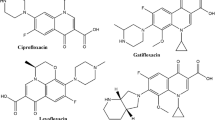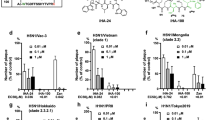Abstract
THERE are few clinically effective antiviral compounds (5-iodo-2′-deoxyuridine1, N-methyl isatin thiosemicarbazone2, adamantanamine3–5) and they all have the disadvantage of possessing only a narrow spectrum of activity. In human respiratory viral infection, where it is not possible without laboratory investigation to identify precisely the responsible pathogen (and then only in restrospect), it would be useful to have a compound which possessed a spectrum of activity embracing many of the viruses known to be commonly involved.
This is a preview of subscription content, access via your institution
Access options
Subscribe to this journal
Receive 51 print issues and online access
$199.00 per year
only $3.90 per issue
Buy this article
- Purchase on Springer Link
- Instant access to full article PDF
Prices may be subject to local taxes which are calculated during checkout
Similar content being viewed by others
References
Kaufman, H. E., Chemotherapia, 7, 1 (1963).
Bauer, D. J., St Vincent, L., Kempe, C. H., and Downie, A. W., Lancet, ii, 494 (1963).
Grunert, R. R., McGahen, J. W., and Davies, W. L., Virology, 26, 262 (1965).
Wood, T. R., Ann. NY Acad. Sci., 130 (1), 419 (1965).
Quilligan, J. J., J. Pediat., 69, 572 (1966).
Howe, C., Lee, C. T., and Rose, H. M., Nature, 188, 251 (1960).
Darrell, R. W., and Howe, C., Proc. Soc. Exp. Biol. and Med., 116, 1091 (1964).
Brit. Med. J., ii, 319 (1965).
Rott, R., Z. Naturforsch., 18 b (12), 1127 (1963).
Tamm, I., and Horsfall, F. L., J. Exp. Med., 95, 171 (1952).
Padgett, B. L., and Walker, D. L., J. Bact., 87 (2), 363 (1964).
Seto, J. T., and Rott, R., Virology, 30, 731 (1966).
Webster, R. G., and Laver, W. G., J. Immunol., 99 (1), 49 (1967).
Edmond, J. D., Johnston, R. G., Kidd, D., Rylance, H. J., and Somerville, R. G., Brit. J. Pharmacol. Chemother., 27, 415 (1966).
Warren, L., J. Biol. Chem., 234, 1971 (1959).
Lineweaver, H., and Burk, D., J. Amer. Chem. Soc., 56, 658 (1934).
Herrmann, E. C., Gabliks, J., Engle, C., and Perlman, P. L., Proc. Soc. Exp. Biol., 103, 625 (1960).
Kucera, L. S., and Herrmann, E. C., Proc. Soc. Exp. Biol. and Med., 122 (1), 258 (1966).
Beare, A. S., Bynoe, M. L., and Tyrrell, D. A. J., Lancet, i, 843 (1968).
Author information
Authors and Affiliations
Rights and permissions
About this article
Cite this article
BRAMMER, K., MCDONALD, C. & TUTE, M. Antiviral Properties of 1-Phenoxymethyl-3,4-Dihydro and 1,2,3,4-Tetrahydroisoquinolines. Nature 219, 515–517 (1968). https://doi.org/10.1038/219515a0
Received:
Revised:
Issue Date:
DOI: https://doi.org/10.1038/219515a0
This article is cited by
-
A simple plaque assay for influenza A2 viruses and its application to antiviral screening
Archiv f�r die gesamte Virusforschung (1971)
-
Die Aktivität bakterieller, viraler und animalischer Neuraminidasen
Naunyn-Schmiedebergs Archiv für Pharmakologie (1969)
Comments
By submitting a comment you agree to abide by our Terms and Community Guidelines. If you find something abusive or that does not comply with our terms or guidelines please flag it as inappropriate.



